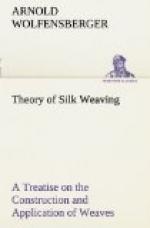The drawing-in drafts which we have described under the head of “Point draws,” are used mostly to obtain the various pointed and zigzag effects.
* * * * *
SECTION DRAWS
[Illustration: Fig. 10]
* * * *
[Page 12] [Illustration: Fig. 11]
* * * *
[Illustration: Fig. 12]
* * * *
[Illustration: Fig. 13]
* * * *
[Illustration: Fig. 14]
* * * *
[Page 13] [Illustration: Fig. 15]
This division of drawing-in drafts is used extensively in silk manufacturing; for instance, in all fabrics having a ground warp and a binder warp, also in double-face goods, or where two different weaves are combined in one effect.
One or more threads are drawn on the first section, then one or more on a second and third, if the harness is divided in so many sets.
The following examples will illustrate the principle of these draws.
In Fig. 10, shafts 1, 2, 3, 4 from the first set, shafts 5 and 6 the second, 8 threads are drawn straight on the first, then 2 on the second section.
Fig. 11, first set shafts 1 to 6 inclusive, second set shafts 7 and 8.
Fig. 12 is drawn end and end on two sections having 8 shafts each.
Figs. 13, 14 and 15, while not strictly belonging to the class of section draws, may, however, be considered under this heading. The idea is to draw a certain number of ends in one part of the harness and another group in another part, be it straight, point or skip, which will cause the effect on the cloth to be accordingly transposed or broken up.
&nb
sp; [Page
15]
*
* * * *
THE WEAVES AND THEIR CONSTRUCTION
In any woven fabric we distinguish two systems of threads, the Warp or Chain, running lengthways in the cloth, and the Filling or Weft, crossing the former at right angles.
This crossing or interlacing consists of every individual warp-thread being placed alternately under and over one or more threads of the filling system. The arrangement of this interlacing is technically called the Weave, and the variety in which the points of crossing can be distributed is practically endless.
It is principally the weave that lends to a fabric its character, influenced, of course, by the material used, the size and tension of the threads and the combination of the colors.
The weaves are divided into three main classes: the Foundation weaves. In the silk business they are known under the following names:
#The Taffeta Weave,
The Serge Weave,
The Satin Weave.#




